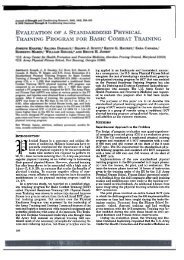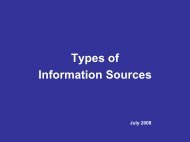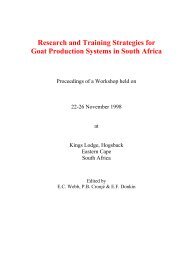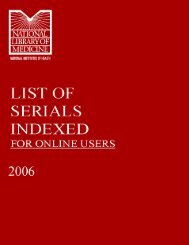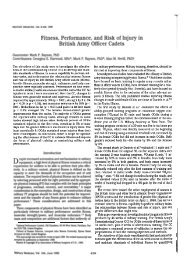Digital divide and e-governance in South Africa - Library
Digital divide and e-governance in South Africa - Library
Digital divide and e-governance in South Africa - Library
Create successful ePaper yourself
Turn your PDF publications into a flip-book with our unique Google optimized e-Paper software.
The purpose of this paper is to provide a critical analysis on how <strong>South</strong> <strong>Africa</strong>n government is engaged <strong>in</strong> e-<br />
<strong>governance</strong> <strong>in</strong> order to improve operations <strong>and</strong> service delivery <strong>in</strong> the public sector. This will be dome by evaluat<strong>in</strong>g<br />
<strong>and</strong> analyz<strong>in</strong>g different websites of <strong>South</strong> <strong>Africa</strong>n government departments.<br />
2. <strong>South</strong> <strong>Africa</strong> <strong>and</strong> the digital <strong>divide</strong><br />
Just like many other countries, <strong>South</strong> <strong>Africa</strong> is also affected by the digital <strong>divide</strong>. In 1994 the new <strong>South</strong> <strong>Africa</strong> was<br />
born <strong>and</strong> great optimism <strong>and</strong> hope characterized the nation. This section will provide current state of the digital <strong>divide</strong><br />
<strong>in</strong> <strong>South</strong> <strong>Africa</strong>. In order to achieve that it will address the follow<strong>in</strong>g: current overview of <strong>South</strong> <strong>Africa</strong>, Internet usage,<br />
factors contribut<strong>in</strong>g to the digital <strong>divide</strong>, <strong>and</strong> attempts to bridge the digital <strong>divide</strong> <strong>in</strong> <strong>South</strong> <strong>Africa</strong>. Many people<br />
anticipated the new policies <strong>and</strong> firm measures of redness would contribute to the creation of a more equitable <strong>and</strong><br />
fair society that would enable <strong>South</strong> <strong>Africa</strong> to become a player <strong>in</strong> the global economy (Czerniewicz, 2004). What<br />
makes <strong>South</strong> <strong>Africa</strong> <strong>in</strong>terest<strong>in</strong>g <strong>in</strong> terms of the digital <strong>divide</strong> is the country’s multi ethnic <strong>and</strong> multi-l<strong>in</strong>gual profile. The<br />
cultural background of the people reflects the different mother tongues <strong>and</strong> language use of students<br />
(Guðmundsdóttir, 2005).<br />
<strong>South</strong> <strong>Africa</strong> is the fourth largest country <strong>in</strong> the Commonwealth <strong>and</strong> has the sixth largest population. With fifty per<br />
cent of its population <strong>in</strong> urban areas <strong>and</strong> has a highest rate of urbanization than most Sub-Saharan countries<br />
(Ak<strong>in</strong>sola; Herselman & Jacobs, 2005).<br />
Accord<strong>in</strong>g to Trusler (2003) <strong>South</strong> <strong>Africa</strong> has to deal with a number of challenges before they can beg<strong>in</strong> with any<br />
<strong>in</strong>itiatives for bridg<strong>in</strong>g the digital <strong>divide</strong>. They challenges issues are as follows Trusler (2003):<br />
A high level of <strong>in</strong>equality;<br />
A weak ICT <strong>in</strong>frastructure, particularly <strong>in</strong> rural areas;<br />
A lack of ICT read<strong>in</strong>ess <strong>in</strong> government<br />
More press<strong>in</strong>g dem<strong>and</strong>s <strong>in</strong> the public service that makes ICT development a lower priority <strong>in</strong> budget terms.<br />
ICT <strong>in</strong>dicators are used to measure how widely diffused <strong>and</strong> accessible (real access, profiled by proximity, language<br />
<strong>and</strong> cost) are ICTs across all regions <strong>and</strong> sectors of society. It further measures how ICT’s are be<strong>in</strong>g used by<br />
<strong>in</strong>dividuals, households, communities, government, the bus<strong>in</strong>ess sector <strong>and</strong> civil society to improve their livelihoods<br />
or operations (Lewis, 2007; SADoC, 2006). See Table 1.










